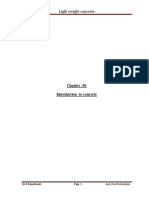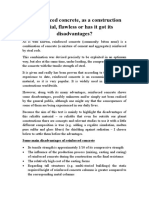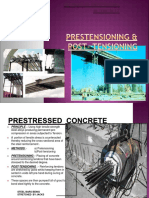Lec 3 CE 806 RCM Beams - Working Stress Method
Lec 3 CE 806 RCM Beams - Working Stress Method
Uploaded by
wasimkhaliqCopyright:
Available Formats
Lec 3 CE 806 RCM Beams - Working Stress Method
Lec 3 CE 806 RCM Beams - Working Stress Method
Uploaded by
wasimkhaliqOriginal Description:
Original Title
Copyright
Available Formats
Share this document
Did you find this document useful?
Is this content inappropriate?
Copyright:
Available Formats
Lec 3 CE 806 RCM Beams - Working Stress Method
Lec 3 CE 806 RCM Beams - Working Stress Method
Uploaded by
wasimkhaliqCopyright:
Available Formats
NUST Institute of Civil Engineering
CE 806
Reinforced Concrete Members
Alternate Design Method (Working
Stress Method)
Dr. Wasim Khaliq
Advantages of Reinforced Concrete as a
Structural Material
It has considerable compressive strength per unit cost compared with most
other materials.
Reinforced concrete has great resistance to the actions of fire and water.
Reinforced concrete structures are very rigid.
It is a low-maintenance material.
It has a very long service life. Under proper conditions, reinforced concrete
structures can be used indefinitely without reduction of their load carrying
abilities.
A special feature of concrete is its ability to be cast into an extraordinary variety
of shapes from simple slabs, beams, and columns to great arches and shells.
In most areas, concrete takes advantage of inexpensive local materials (sand,
gravel, and water) and requires relatively small amounts of cement and
reinforcing steel.
A lower grade of skilled labor is required for erection as compared with other
materials such as structural steel.
Disadvantages of Reinforced Concrete as a
Structural Material
Concrete has a very low tensile strength, requiring the use of tensile reinforcing.
Forms are required to hold the concrete in place until it hardens sufficiently. In
addition, false-work or shoring may be necessary to keep the forms in place for
roofs, walls, floors, and similar structures until the concrete members gain
sufficient strength to support themselves.
The low strength per unit of weight of concrete leads to heavy members. This
becomes an increasingly important matter for long-span structures, where
concretes large dead weight has a great effect on bending moments.
Lightweight aggregates can be used to reduce concrete weight, but the cost of
the concrete is increased.
The low strength per unit of volume of concrete means members will be
relatively large, an important consideration for tall buildings and long-span
structures.
The properties of concrete vary widely because of variations in its proportioning
and mixing.
Reinforced Concrete Beam Behavior
Plain concrete beams are inefficient as flexural members because the
tensile strength (modulus of rupture) is a small fraction of the compressive
strength.
Such beams fail on the tension side at low loads long before the strength of
the concrete on the compression side has been fully utilized.
To cater for, steel reinforcing bars are placed on the tension side as close to
the extreme tension fiber as is compatible with proper fire and corrosion
protection of the steel.
In such a reinforced concrete beam, the tension caused by the bending
moments is chiefly resisted by the steel reinforcement, while the concrete
alone is usually capable of resisting the corresponding compression.
Such joint action of the two materials is ensured if relative slip is prevented.
Reinforced Concrete Beam Behavior
Rectangular beams fail in compression
when the concrete strains reach
values of about 0.003 to 0.004
Design Basis
Elastic Behavior
At low stresses (fc/2) concrete is seen close to near elastic (stressstrain is close to proportional) with strain of about .005
Steel is elastic upto yield point with large strain of .002
Two strains being equal in reinforced concrete
Axial Capacity
or
Transformed Section
or
or
Stresses Elastic and Section Uncracked
Example 3.1
Stresses Elastic and Section Cracked
Stresses Elastic and Section Cracked
= 0
(1)
implies
Example 3.2
22.3 ksi
1.39 ksi
0.48 ksi
2.8 ksi
Stresses Elastic and Section Cracked
Stresses Elastic and Section Cracked
You might also like
- BodyDocument92 pagesBodyearl vergille reveloNo ratings yet
- Reinforced Concrete Design Lecture-1-2Document32 pagesReinforced Concrete Design Lecture-1-2Harold Jackson Mtyana100% (2)
- Reinforcement C-WPS OfficeDocument7 pagesReinforcement C-WPS OfficeNoah Oluwatoyin AderiyikeNo ratings yet
- Prestressed ConcreteDocument14 pagesPrestressed ConcreteMilenaNo ratings yet
- Department of Civil Engineering: Presented byDocument13 pagesDepartment of Civil Engineering: Presented byavi boseNo ratings yet
- Typologies of CementDocument250 pagesTypologies of CementRHYME KIDSNo ratings yet
- Prestressed Concrete VS Reinforced ConcreteDocument15 pagesPrestressed Concrete VS Reinforced ConcreteBlackFlameNo ratings yet
- Prestressed ConcreteDocument18 pagesPrestressed ConcreteLarete PaoloNo ratings yet
- Ductility 4Document8 pagesDuctility 4reagan omondiNo ratings yet
- Concrete Basics PDFDocument30 pagesConcrete Basics PDFDarshan Rokztar100% (1)
- Te HWDocument2 pagesTe HWAngel RondillaNo ratings yet
- Arc 022 Building Technology 1: Department of ArchitectureDocument19 pagesArc 022 Building Technology 1: Department of ArchitectureLenard UsonNo ratings yet
- Ce DesignDocument6 pagesCe DesignJhona PancitoNo ratings yet
- CHAPTER 1: Introduction: 1.1 General ReviewDocument9 pagesCHAPTER 1: Introduction: 1.1 General ReviewKubaNo ratings yet
- Acknowledgement: M.R. Head of Civil Engineering Department, For Inspiring Take This Project. I Also ExpressedDocument18 pagesAcknowledgement: M.R. Head of Civil Engineering Department, For Inspiring Take This Project. I Also ExpressedRicky RickxNo ratings yet
- Advantages of Prestressed ConcreteDocument4 pagesAdvantages of Prestressed Concreteiceskater23320No ratings yet
- Fundamentals of Reinforced ConcreteDocument28 pagesFundamentals of Reinforced ConcreteHarold Jackson MtyanaNo ratings yet
- Durability Characteristics of Reinforced Concrete ColumnDocument6 pagesDurability Characteristics of Reinforced Concrete ColumnInternational Journal of Application or Innovation in Engineering & ManagementNo ratings yet
- Design of Concrete Structures Chapter 1: 1.2 Structural FormsDocument1 pageDesign of Concrete Structures Chapter 1: 1.2 Structural FormsjcvalenciaNo ratings yet
- TMT BarsDocument26 pagesTMT BarsPardeep KushwahaNo ratings yet
- Prestressed ConcreteDocument6 pagesPrestressed ConcreteSoumyarup DebNo ratings yet
- Construction TechnologyDocument78 pagesConstruction TechnologyAldina MuthoniNo ratings yet
- 09 - Chapter 1Document16 pages09 - Chapter 1pratik chauhanNo ratings yet
- Uses, Applications, Advantages and Disadvantages of ViguetasDocument4 pagesUses, Applications, Advantages and Disadvantages of ViguetasScribdTranslationsNo ratings yet
- DPSC Mod 1 IntroductionDocument12 pagesDPSC Mod 1 IntroductionKajalNo ratings yet
- Is Reinforced Concrete, As A Construction Material, Flawless or Has It Got Its DisadvantagesDocument2 pagesIs Reinforced Concrete, As A Construction Material, Flawless or Has It Got Its DisadvantagesAnthony DernellisNo ratings yet
- When and Why To Choose Prestressed Concrete As A Structural MaterialDocument1 pageWhen and Why To Choose Prestressed Concrete As A Structural MaterialGiamaica LegaspiNo ratings yet
- Reinforced ConcreteDocument12 pagesReinforced ConcretehistorymakeoverNo ratings yet
- Combining Steel and ConcreteDocument2 pagesCombining Steel and ConcreteIshwarya SrikanthNo ratings yet
- Civil Concrete Technology Lectures Notes DownloadDocument12 pagesCivil Concrete Technology Lectures Notes DownloadMildred Ivy Bangoy Pangilinan0% (1)
- Composite Construction MethodsDocument33 pagesComposite Construction Methodserika100% (3)
- Advantages and Limitations of Prestressed ConcreteDocument4 pagesAdvantages and Limitations of Prestressed ConcreteKanadeTachibanaNo ratings yet
- RCC2Document18 pagesRCC2Mangam RajkumarNo ratings yet
- Prestressed Concrete: 2Nd Semester 2020-2021Document7 pagesPrestressed Concrete: 2Nd Semester 2020-2021Nino MontaNo ratings yet
- Prestressed ConcreteDocument32 pagesPrestressed Concreteshrikantharle0% (1)
- Articles Difference Between RCC and Prestressed ConcreteDocument12 pagesArticles Difference Between RCC and Prestressed ConcreteLyka Jane PesiganNo ratings yet
- Advantage Pre Stresssed ConcreteDocument2 pagesAdvantage Pre Stresssed Concreteyesuf abdulhakimNo ratings yet
- Prestressed Concrete STRUCTURES 1) Advantages of Prestressed ConcreteDocument2 pagesPrestressed Concrete STRUCTURES 1) Advantages of Prestressed ConcreteKannan CrNo ratings yet
- Cec 313 Lect NoteDocument10 pagesCec 313 Lect NoteSamson Mide FolorunshoNo ratings yet
- CMT Research 2Document5 pagesCMT Research 2Fred RecaldeNo ratings yet
- Pre Stressed ConcreteDocument37 pagesPre Stressed Concretejustc159No ratings yet
- PRINCIPLES RC MODULE Unit 1Document16 pagesPRINCIPLES RC MODULE Unit 1Stephen Bulay-ogNo ratings yet
- RCD PLATE1 IntoductionDocument6 pagesRCD PLATE1 IntoductionEugene TongolNo ratings yet
- PresconDocument3 pagesPresconsam dorilloNo ratings yet
- CE 552 Lecture 1Document31 pagesCE 552 Lecture 1Aljon Maglalang JimenezNo ratings yet
- Activity 1 in Pre-StressedDocument3 pagesActivity 1 in Pre-StressedFrancis Prince ArtiagaNo ratings yet
- Prestressed ConcreteDocument32 pagesPrestressed ConcretejaffnaNo ratings yet
- Chapter Five Composite Structures (Concrete and Steel)Document15 pagesChapter Five Composite Structures (Concrete and Steel)Assefa Nigussie100% (1)
- Structures Assignment 1Document24 pagesStructures Assignment 1vajhulasriswethanagasai27No ratings yet
- CONCRETEDocument2 pagesCONCRETEJan Marie VaronaNo ratings yet
- Introduction To: Prestressed ConcreteDocument26 pagesIntroduction To: Prestressed ConcreteTerityNo ratings yet
- Chapter 1 IntroductionDocument10 pagesChapter 1 Introductionzeru3261172No ratings yet
- Study of Seismic and Wind Effect On Multi Storey R.C.C. Steel and Composite BuildingDocument6 pagesStudy of Seismic and Wind Effect On Multi Storey R.C.C. Steel and Composite BuildingAkshay DobleNo ratings yet
- CEN 330 - Concrete Design I: T. SalemDocument9 pagesCEN 330 - Concrete Design I: T. SalemRoula SerhalNo ratings yet
- Definition of PrestressDocument21 pagesDefinition of PrestressShashank PatoleNo ratings yet
- Structural - Prestressed ConcreteDocument21 pagesStructural - Prestressed Concretejaderic buisingNo ratings yet
- Lec 1Document21 pagesLec 1henok7888No ratings yet
- Unit 2Document142 pagesUnit 2srikarryettapu.ai22No ratings yet
- How To Write A Good ReviewDocument2 pagesHow To Write A Good ReviewwasimkhaliqNo ratings yet
- Lec 9 CE 806 Deep Beams and CorbelsDocument9 pagesLec 9 CE 806 Deep Beams and CorbelswasimkhaliqNo ratings yet
- CE 310 Lec 9 - Precast Concrete ConstructionDocument19 pagesCE 310 Lec 9 - Precast Concrete ConstructionwasimkhaliqNo ratings yet
- CE 308 Lec 13 Special Weather ConcretingDocument12 pagesCE 308 Lec 13 Special Weather ConcretingwasimkhaliqNo ratings yet
- CE 419 Lec 1 Bond and Developement LengthDocument55 pagesCE 419 Lec 1 Bond and Developement LengthwasimkhaliqNo ratings yet
- Lec 5 CE 806 RCM Development, Anchorage and Splicing of ReinforcementDocument69 pagesLec 5 CE 806 RCM Development, Anchorage and Splicing of ReinforcementwasimkhaliqNo ratings yet
- CE 308 Lec 4 AdmixturesDocument25 pagesCE 308 Lec 4 AdmixtureswasimkhaliqNo ratings yet
- Lec 8 CE 806 Behavior of Short ColumnsDocument66 pagesLec 8 CE 806 Behavior of Short ColumnswasimkhaliqNo ratings yet
- CE 308 Lec 7 Mixing, Handling and Placing of ConcreteDocument29 pagesCE 308 Lec 7 Mixing, Handling and Placing of ConcretewasimkhaliqNo ratings yet
- CE 308 Lec 9 Mix Design of ConcreteDocument33 pagesCE 308 Lec 9 Mix Design of ConcretewasimkhaliqNo ratings yet
- A Compact Hilbert Curve Fractal Antenna On Metamaterial Using CSRRDocument6 pagesA Compact Hilbert Curve Fractal Antenna On Metamaterial Using CSRRfahmiNo ratings yet
- Superplasticity & Superplastic Materials: Presented By:-1 2Document12 pagesSuperplasticity & Superplastic Materials: Presented By:-1 2Rohan ShuklaNo ratings yet
- Unit 039 Further Maths A2 2018-2019CDocument12 pagesUnit 039 Further Maths A2 2018-2019CtanNo ratings yet
- Magnetic Fields AS Unit 4: Drawing Field DiagramsDocument6 pagesMagnetic Fields AS Unit 4: Drawing Field DiagramsL5YARBNo ratings yet
- Active and Semi-Active Vibration Isolation: D. KarnoppDocument9 pagesActive and Semi-Active Vibration Isolation: D. KarnoppDiabloNo ratings yet
- Appendices PDFDocument381 pagesAppendices PDFabdulqadirghoriNo ratings yet
- Chemistry 31 - Quantitative Analysis Exam #2, April 22, 2009Document6 pagesChemistry 31 - Quantitative Analysis Exam #2, April 22, 2009Agatha BermudezNo ratings yet
- National Standard Examination in Physics - 1999Document15 pagesNational Standard Examination in Physics - 1999tranquil_452889939No ratings yet
- Passive Suspoension Modeling Using Matlab Quarter Car Model Imput Isngal Step TypeDocument6 pagesPassive Suspoension Modeling Using Matlab Quarter Car Model Imput Isngal Step TypeChristian Mavarez0% (2)
- AnsysDocument46 pagesAnsysapi-3719538100% (9)
- Triton x-305 PDFDocument2 pagesTriton x-305 PDFAnonymous C3BD7OdNo ratings yet
- The Particle Nature of MatterDocument70 pagesThe Particle Nature of MatterWowie FalcatanNo ratings yet
- A Comparison of The Fracture Criteria of Griffith and BarenblattDocument12 pagesA Comparison of The Fracture Criteria of Griffith and BarenblattIgnasi AliguerNo ratings yet
- Matlab ExamDocument4 pagesMatlab ExamSawan Singh MaharaNo ratings yet
- Physics I Problems PDFDocument1 pagePhysics I Problems PDFbosschellenNo ratings yet
- List of Comparatives and SuperlativesDocument8 pagesList of Comparatives and SuperlativesAndy Jhosep Lopez Gomez100% (1)
- 132 KV Tower Analysis PDFDocument11 pages132 KV Tower Analysis PDFViswanathan VNo ratings yet
- Yaskawa SGDM Servo User's ManualDocument416 pagesYaskawa SGDM Servo User's Manualtom corvin67% (3)
- MATERIAL Mechanical DesignDocument13 pagesMATERIAL Mechanical DesignSchaieraNo ratings yet
- HW5 SolDocument11 pagesHW5 Solondutz33% (3)
- CPP Code Sun PositionDocument4 pagesCPP Code Sun Positionsiddharthpande777No ratings yet
- TransientDocument888 pagesTransientBimantara PrayogoNo ratings yet
- Flexibility Method (Composite Structures)Document10 pagesFlexibility Method (Composite Structures)dixn__No ratings yet
- ACD Lab Manual Spur Gear DesignDocument4 pagesACD Lab Manual Spur Gear Designbalaguru780% (1)
- How To Close A Loop in CAEPIPEDocument7 pagesHow To Close A Loop in CAEPIPEalmustanir_903004759No ratings yet
- Rapayi T Solar DistillerDocument13 pagesRapayi T Solar DistillertapiwaNo ratings yet
- Tutor Registration FormDocument10 pagesTutor Registration Formkumaresanmanika2543No ratings yet
- Synopsis: in Order To Decrease Cross Sectional Area of Structural Members, Ultra High StrengthDocument16 pagesSynopsis: in Order To Decrease Cross Sectional Area of Structural Members, Ultra High StrengthHector Alberto Garcia LopezNo ratings yet
- RP 7523Document60 pagesRP 7523CAC-39.01No ratings yet
- DTFT, DFT, FFT PDFDocument14 pagesDTFT, DFT, FFT PDFsamiNo ratings yet



































































































